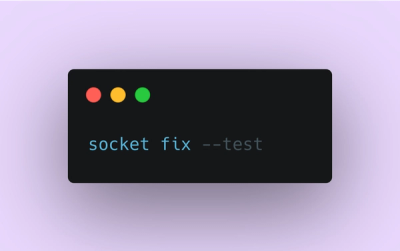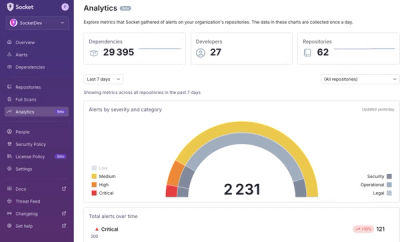
Product
Introducing Socket Fix for Safe, Automated Dependency Upgrades
Automatically fix and test dependency updates with socket fix—a new CLI tool that turns CVE alerts into safe, automated upgrades.
box-mcp-server
Advanced tools
You will need:
BOX_USER_IDand one of the following:
BOX_JWT_BASE64 (recommended)BOX_JWT_CONFIG_PATHBOX_JWTUsing a JWT Config allows persistent connection to Box.
You will need a paid Box enterprise account, or you can sign up for a free developer account (make sure you are signed out of Box before clicking that link).
Visit the Box Developer Console and create a new application. Make sure the authorization type is JSON Web Token.
Go to Configuration > Add and Manage Public Keys and Generate a Public/Private Keypair.
If you have not already, Box prompt you to set up 2 factor authentication and Authorize the application as an administrator in your box account. You will need to:
App + Enterprise Access, andmake API calls using the as-user header optionvia the Box Application's Configuration page. Make sure to reauthorize the application if you are modifying these settings.
To encode your JWT in Base64, you can use the following command in your terminal:
cat /path/to/your/box-jwt-config.json | base64
Replace /path/to/your/box-jwt-config.json with the actual path to your JWT configuration file. This will output the Base64 encoded JWT which you can then use in your environment variables.
{
"mcpServers": {
"box": {
"command": "npx",
"args": ["box-mcp-server"],
"env": {
"BOX_JWT_BASE64": "YOUR_BASE64_ENCODED_JWT",
"BOX_USER_ID": "123456"
}
}
}
}
Using a developer token is the easiest way to integrate with Box, but will only last 60 minutes.
To get started, set the BOX_DEV_TOKEN to a Box Developer Token.
Begin by visiting the Box Developer Console and create a new application. The authorization type does not currently matter, as all support Box Developer Token.
Once your application is created, navigate to its configuration setings and click Generate Developer Token.
{
"mcpServers": {
"box": {
"command": "npx",
"args": ["box-mcp-server"],
"env": {
"BOX_DEV_TOKEN": "YOUR_DEV_TOKEN_GOES_HERE"
}
}
}
}
Before you begin, ensure you have the following installed:
To set up the development environment, follow these steps:
Fork the repository
Clone Your Fork:
git clone https://github.com/YOUR_USERNAME/box-mcp-server.git
cd box-mcp-server
Add Upstream Remote
git remote add upstream https://github.com/hmk/box-mcp-server.git
Copy the dotenv file
cp .env.template .env
Install dependencies:
npm install
Run watch to keep index.js updated:
npm run watch
Start the model context protocol development server:
dotenv npx @modelcontextprotocol/inspector node PATH_TO_YOUR_CLONED_REPO/dist/index.js
If the development server did not load the environment variable correctly, set the BOX_DEV_TOKEN on the left-hand side of the mcp inspector.
FAQs
MCP Server for interacting with Box
We found that box-mcp-server demonstrated a healthy version release cadence and project activity because the last version was released less than a year ago. It has 0 open source maintainers collaborating on the project.
Did you know?

Socket for GitHub automatically highlights issues in each pull request and monitors the health of all your open source dependencies. Discover the contents of your packages and block harmful activity before you install or update your dependencies.

Product
Automatically fix and test dependency updates with socket fix—a new CLI tool that turns CVE alerts into safe, automated upgrades.

Security News
CISA denies CVE funding issues amid backlash over a new CVE foundation formed by board members, raising concerns about transparency and program governance.

Product
We’re excited to announce a powerful new capability in Socket: historical data and enhanced analytics.